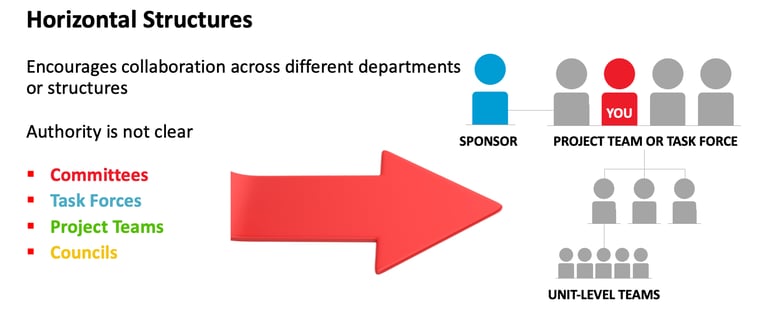I consulted today with an executive who threw up her hands in frustration and said, “I don’t have the authority to make that decision!” It was clear that she wished she did. I hear this kind of complaint all the time in complex systems. (This one, an academic medical center, represents the apex of organizational complexity. Things just don’t get any more convoluted than they do in major teaching hospitals – trust me.)
Leaders often long for the days when most of their work took place in the “vertical organization” – within their own department or service line or “silo.”

The Vertical Structure of organizations is where most of us start out – working in operations, living inside a department or a profession, DOING something, and doing it well. If someone laments about the “silo-thinking” in a company, you can bet they are referring to its vertical architecture. The way we’ve constructed most business organizations, “silo” thinking is inevitable – after all, we group people into specialty areas where they often share the same background, training, and experience. We may reinforce the boundaries by grouping them together physically, giving them the same information to work with, measuring their efforts in the same way (think – departmental P&L or budget process), and rewarding them with advancement – inside the department. They may even read the same journals and attend the same conferences. The entire system we construct creates loyalty – and silos.
In a hierarchy, you can direct at least some if not most of the action. But as your career advances, you will likely spend more and more time in the organization space called the “Horizontal Structure.”

Increasingly, the complex problems we are called on to solve require multi-disciplinary thinking and across-department problem-solving. Welcome to cross-functional, Horizontal Structures. This is where people from different departments and disciplines come together to do work. In this landscape, it's a lot harder to tell who’s boss, harder to know what success looks like, or whether or not success will even be noticed, let alone rewarded. Leading in the Vertical Structure is difficult enough - you need to know how to delegate work, how to manage others, and how to drive projects in your area to completion. Once you’ve proven yourself there, chances are you’ll be rewarded with more responsibility at higher levels. Suddenly your day fills more and more with work in the Horizontal Structure, leading cross-functional teams, and collaborating with groups across the organization. Good luck because horizontal work is more challenging.
It’s a different landscape and it requires a whole different set of skills.
In RACI 2.0 terms, everyone would like to have the “A” which stands for the authority to make decisions. It means the buck stops here. This is what often comes with POSITIONAL AUTHORITY – when someone has a superior position in the hierarchy. People comply when the “boss” asks for something.
But there are three other forms of authority, which are important in horizontal work, where you may not have much positional authority to rely on. All of these are components of INFLUENCE.
- RELATIONAL AUTHORITY: This means people may be influenced by you because you have built a strong relationship with them. They trust you. They will listen to your position with an open mind. With friends, you can ask for help and give it. In complex organizations, it is always wise to build your cross-functional relationships.
- ACCESS: This means that although you may not have positional authority yourself, you have access to the person who does. Do you have access to the decision-maker? Can you get on their calendar? Will they take your call?
- EXPERTISE: Do you have a good reputation with the decision-maker(s)? Do they trust your advice? Credibility can be based on reputation, on expertise, on experience – protect whatever makes you credible.
If you don’t have an “A” for making the decisions in the Horizontal Structure, chances are that you do at least have a “C” and will be consulted before decisions are made. This may feel like a more powerless position, but if you leverage the three kinds of influence, your authority can be nearly as strong.
“Being powerful is like being a lady. If you have to tell people you are, you aren't.”



